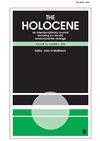Holocene landscape evolution, palaeoclimate and human impact in the Fotsch Valley, Stubai Alps, Austria: Interrogating biomarkers, stable isotopes, macrofossils and palynological indicators from a subalpine mire archive
IF 1.8
3区 地球科学
Q3 GEOGRAPHY, PHYSICAL
引用次数: 0
Abstract
Peatlands are receiving increasing attention in palaeoenvironmental research and represent very useful terrestrial archives for reconstructing vegetation, climate and human history. Previous palaeoenvironmental studies in the Fotsch Valley, Stubai Alps, Austria, focused on geoarchaeological investigations on the Ullafelsen representing a very important prehistorical encampment site used by Mesolithic hunter-gatherers (10.9–9.5 cal. kyr BP). In order to contribute to a better understanding of the landscape evolution of the Fotsch Valley, we here studied the close-by subalpine ‘Potsdamer Hütte Mire’ by applying radiocarbon dating as well as elemental, biomarker, compound-specific stable isotope, palynological and macrofossil analyses on bulk peat samples. The calculated age-depth model using R Bacon indicates the beginning of peat formation during the Early Holocene and shows a strongly reduced peat accumulation rate (PAR) from 170 to 121 cm depth (8.5–2.1 cal. kyr BP) and/or a striking hiatus. Results of leaf wax-derived n-alkane biomarkers as well as macrofossils and palynological indicators reflect the local presence of coniferous trees and the synchronous expansion of deciduous trees during the Early Holocene. The above-mentioned strongly reduced PAR and/or hiatus coincides with the Neolithic, the Bronze and the Iron Age, and goes hand in hand with strong changes in vegetation and an increase of micro-charcoal and black carbon. Despite age uncertainties, these changes can be explained with strongly increasing human and livestock activities in form of deforestation, domestic fires and the beginning of Alpine pastoralism. The latter is confirmed by the finding of pasture and cultural indicator pollen (Cerealia-type, Rumex, Plantago lanceolata, Poaceae) occurring since the Middle to Late Bronze Age. The oxygen isotope composition of sugar biomarkers (δ18Osugars) likely reflects the dry versus humid climatic variability associated with the Holocene climatic optimum during the Mesolithic, the Roman Age, the Late Antique Little Ice Age, the Middle Ages and the Little Ice Age.奥地利Stubai阿尔卑斯山Fotsch山谷全新世景观演变、古气候和人类影响:从亚高山沼泽档案中询问生物标志物、稳定同位素、宏化石和孢粉学指标
泥炭地在古环境研究中受到越来越多的关注,是重建植被、气候和人类历史的非常有用的陆地档案。以前在奥地利斯图拜阿尔卑斯山脉的Fotsch山谷进行的古环境研究主要集中在对Ullafelsen的地质考古调查上,Ullafelsen代表了中石器时代狩猎采集者使用的一个非常重要的史前营地(10.9-9.5 cal)。可以BP)。为了更好地了解Fotsch山谷的景观演变,我们在这里通过对散装泥炭样品进行放射性碳定年以及元素、生物标志物、化合物特定稳定同位素、孢粉学和宏观化石分析,研究了附近的亚高山“波茨坦h沼泽”。利用R Bacon计算的年龄-深度模型表明,泥炭形成始于全新世早期,泥炭积累速率(PAR)在170 ~ 121 cm深度(8.5 ~ 2.1 cal)显著降低。(BP)和/或惊人的中断。叶蜡衍生的正构烷烃生物标志物、宏观化石和孢粉学指标反映了早全新世地区针叶树的存在和落叶树的同步扩张。上述PAR的大幅降低和/或中断与新石器时代、青铜时代和铁器时代相吻合,与植被的强烈变化以及微炭和黑碳的增加密切相关。尽管存在年龄的不确定性,但这些变化可以用人类和牲畜活动的急剧增加来解释,其形式是森林砍伐、家庭火灾和高山畜牧业的开始。青铜器时代中晚期以来发现的牧草和文化指示花粉(禾草属、鲁麦属、车前草属、禾科)证实了后者的存在。糖生物标志物(δ18Osugars)的氧同位素组成可能反映了中石器时代、罗马时代、古小冰河期晚期、中世纪和小冰河期与全新世气候适宜期相关的干湿气候变化。
本文章由计算机程序翻译,如有差异,请以英文原文为准。
求助全文
约1分钟内获得全文
求助全文
来源期刊

Holocene
地学-地球科学综合
CiteScore
4.70
自引率
8.30%
发文量
106
审稿时长
4 months
期刊介绍:
The Holocene is a high impact, peer-reviewed journal dedicated to fundamental scientific research at the interface between the long Quaternary record and the natural and human-induced environmental processes operating at the Earth''s surface today. The Holocene emphasizes environmental change over the last ca 11 700 years.
 求助内容:
求助内容: 应助结果提醒方式:
应助结果提醒方式:


